THE THEATRE ORGAN
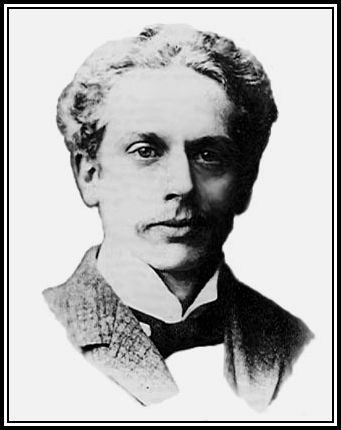 Robert Hope-Jones (1859-1914) Father of The Theatre Organ
Robert Hope-Jones (1859-1914) Father of The Theatre Organ
-oOo-
PART ONE – INTRODUCTION CONTINUED
THE THEATRE ORGAN
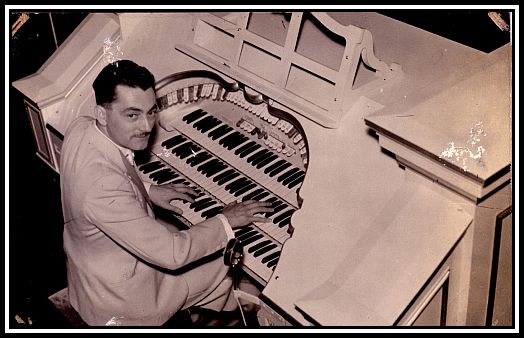 Reginald Dixon at The Mighty Wurlitzer installed at the Granada Theatre Woolwich
Reginald Dixon at The Mighty Wurlitzer installed at the Granada Theatre Woolwich
Mr. Dixon was known as Mr. Blackpool
and was arguably Britain’s most recognisable theatre organist
A Theatre or Cinema Organ is a distinct type of Pipe Organ developed for a specific purpose, which was to entertain an audience and grew to be a unique instrument.
Click here to be entertained in an old-fashioned manner!
Unlike the Pipe Organ where the pipes were built into a decorative casing and remained in full view of the audience, the pipes of the Theatre Organ were placed in chambers and hidden by ornate plasterwork grilles, but allowed the sound to pass into the auditorium.
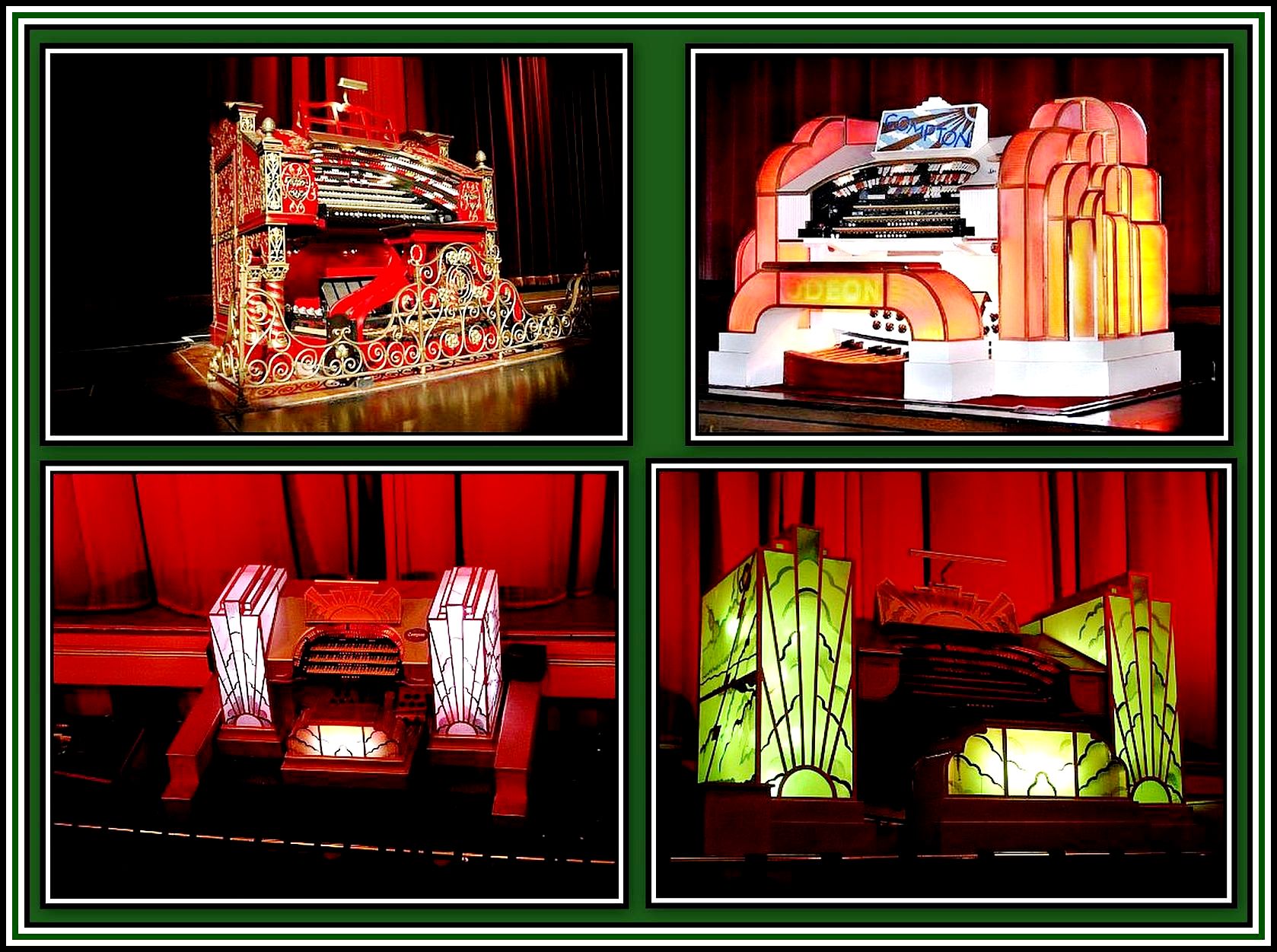 Decorative Theatre Organ Consoles
Decorative Theatre Organ Consoles
Top Left: The Alabama Theater Organ
(Photograph by Sabrina Summers)
Top Right: The Compton Organ, Odeon Cinema, Weston-super-Mare
Bottom: The Compton Organ, Plaza Cinema, Stockport
Click here to hear The Compton Organ of the Plaza Cinema, Stockport being played
Only the console was visible to the audience and was either mounted on a side wall or else on a platform that rose from the orchestra pit to a position of prominence on the stage where it was played. The organ was a Unit Orchestra in that the various sets of pipes (Ranks) imitated the various tone families of a full orchestra (strings, woodwinds, brass etc).
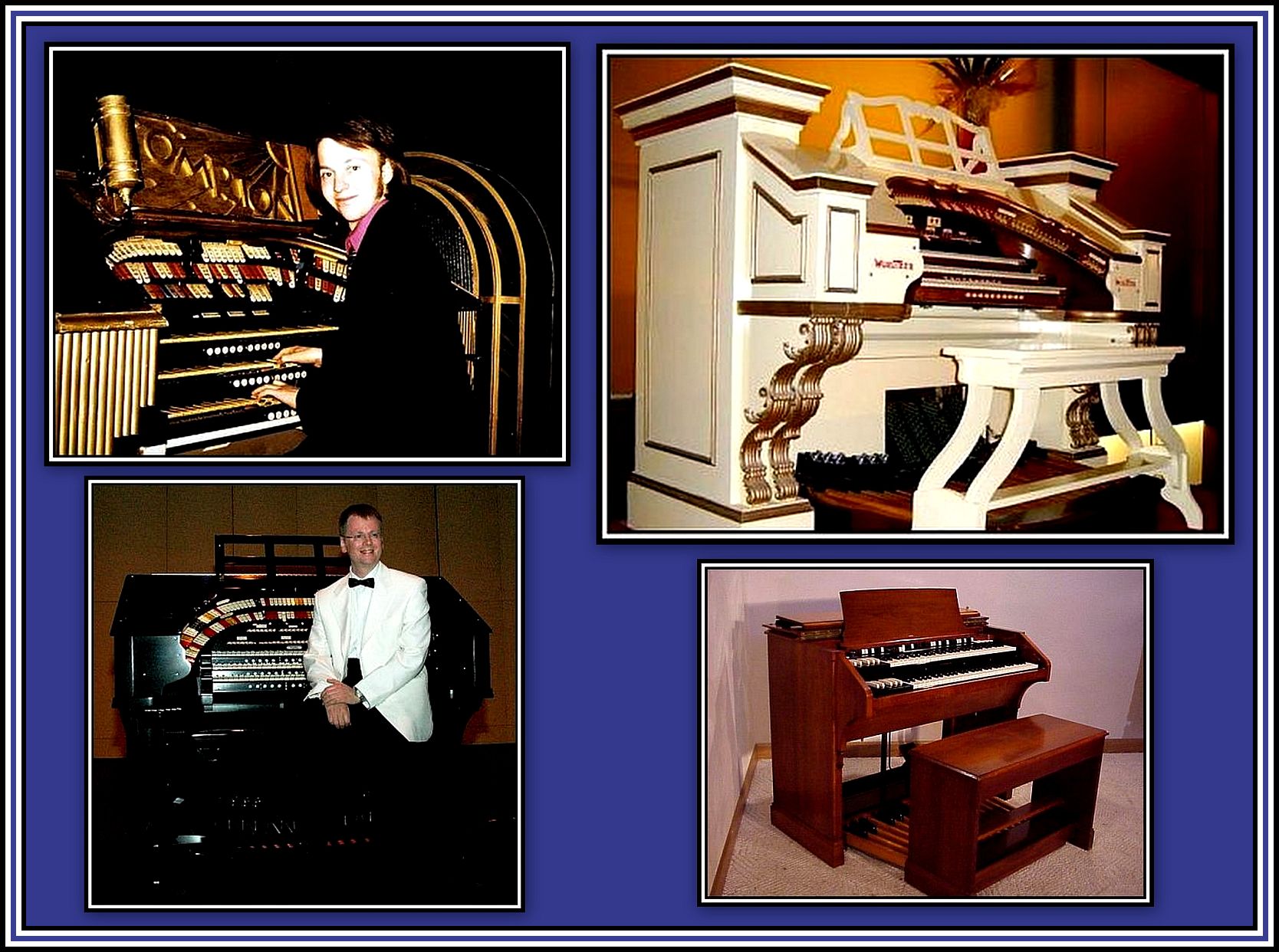 Theatre Organ Consoles
Theatre Organ Consoles
Top Left: Andrew Gilbert at a Compton Theatre Organ
Top Right: The Mighty Wurlitzer Organ of the Granada Theatre Harrow
Bottom Left: Simon Glenhill at a Christie Theatre Organ
Bottom Right: A Hammond Organ
A Theatre Organ is a versatile musical instrument and, in the right hands, can even be played to sound like a train!
Click here to hear an example of this.
—ooOoo—
With the development of film, which at first was silent, it was felt that some kind of music was required to help express the mood and action appearing on the screen and add to the experience. To achieve this, an orchestra was housed in the pit of larger theatres and cinemas while pianists were installed in the smaller houses. Pipe Organs were also installed, but it was soon found that these instruments were unsuitable both for providing the necessary accompaniment to the film or for playing popular music of the day.
—ooOoo—
Robert Hope-Jones was to become the Father of the Theatre Organ with the development of the Unit Orchestra. His skills and talents were recognised by the Rudolph Wurlitzer Company who licensed his name and patents and so developed what would eventually become the Mighty Wurlitzer known to enthusiasts the world over today.
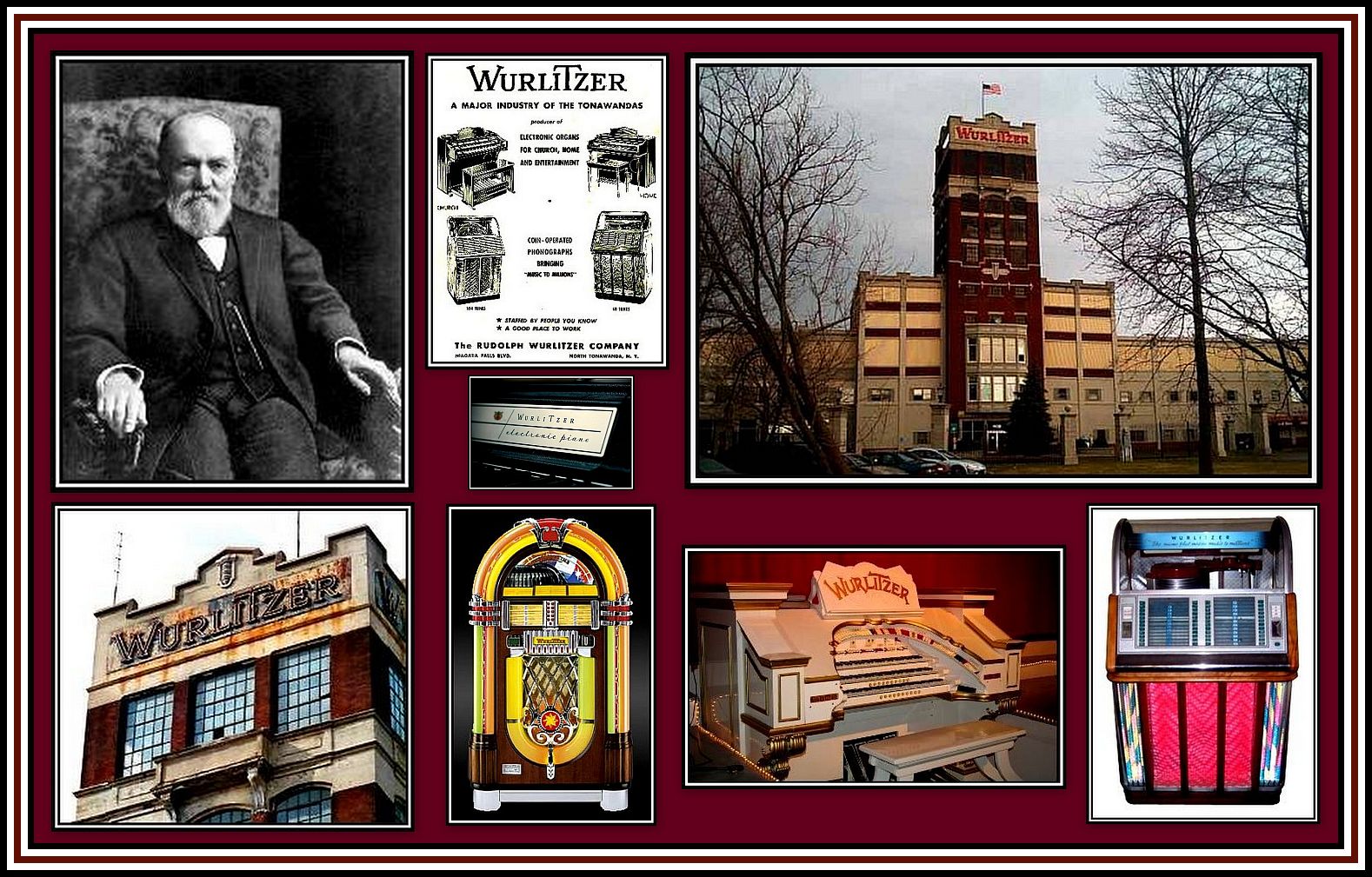 Rudolph Wurlitzer, His Factory & Products
Rudolph Wurlitzer, His Factory & Products
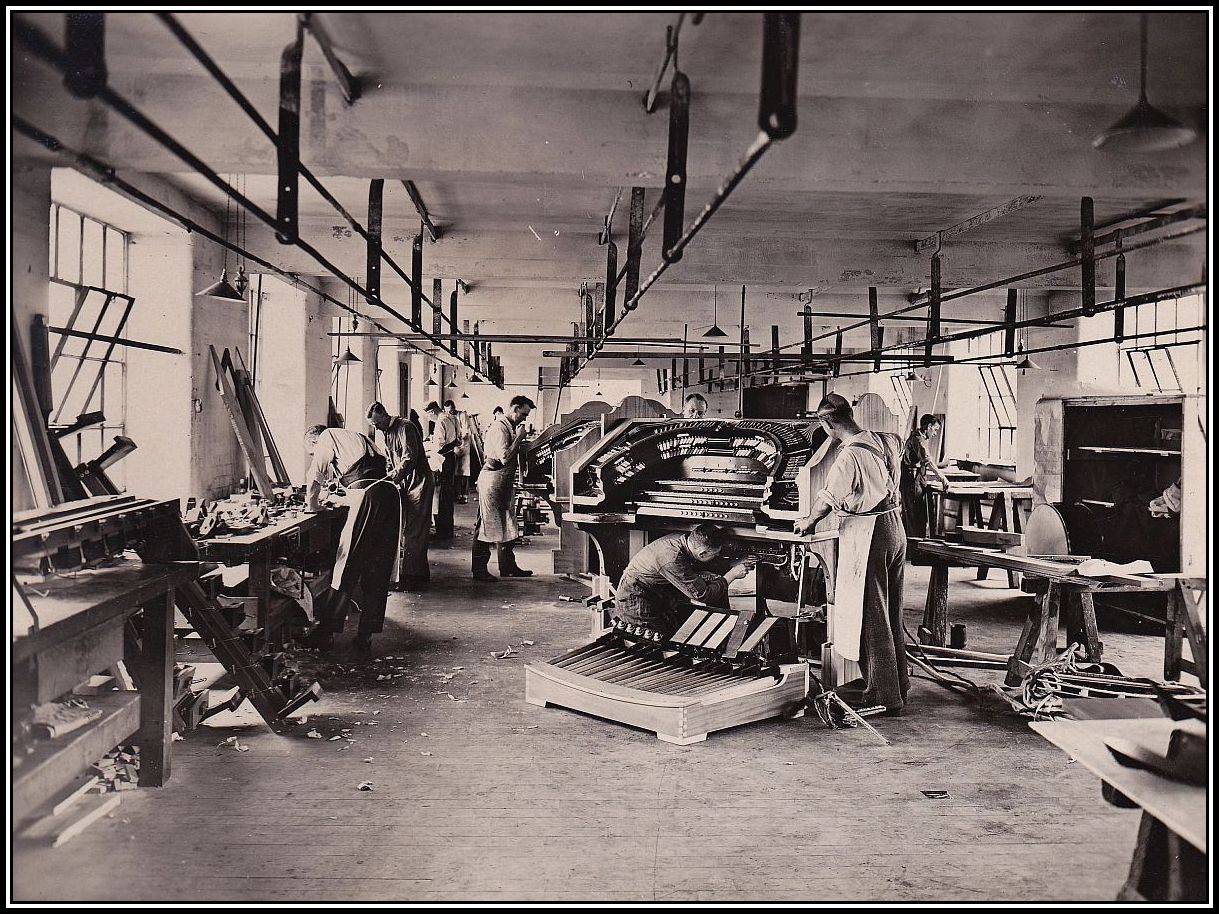 The Wurlitzer Factory, London
The Wurlitzer Factory, London
The factory was at Charlton Kings Road, Kentish Town, London N.W.5
The organ in the foreground was installed at the Troxy Cinema Stepney
while the one immediately behind it was installed at the Empire Theatre Edmonton
(I am grateful to Mr. Wayne Ivany for allowing this photograph to appear here)
-oOo-
Although Robert Hope-Jones did not invent each of the innovations that were combined to produce the modern Theatre Organ, he was the first to successfully combine and use them in a single organ.
-oOo-
Perhaps the single most significant innovation of Mr. Hope-Jones that led to the Theatre Organ, as we know it today, was the application of low-voltage electricity to transmit the depression of the manual keys to the pipes. Prior to this, the Pipe Organ had relied on mechanical linkage between the keys and the pipes. As a result of this imaginative innovation, the console housing the keyboards was linked to the pipes by a flexible wind line and an electrical cable and so could be moved. This led to the console being placed on a moveable platform and stored in the orchestra pit until required. When needed for accompaniment to a film or for solo interludes, it rose up to stage level in spectacular fashion bring the audience’s response to a crescendo.
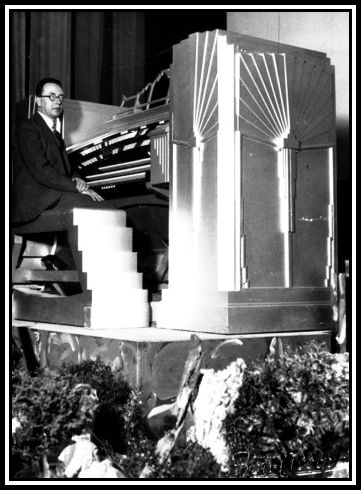 Edward O’Henry at The Capitol Organ (1933) having just risen from the Orchestra Pit
Edward O’Henry at The Capitol Organ (1933) having just risen from the Orchestra Pit
(This photograph is reproduced with permission of Organ Fax)
Click here to see the Theatre Organ rise from beneath Orchestra Pit
(I recommend moving the pointer to 40 seconds, as this is where the organ first appears)
I am amazed not to find other examples of the Theatre Organ
rising from beneath the Orchestra Pit.)
-oOo-
Connecting the keys of the manuals and pedals of a Theatre Organ to the prerequisite pipes involve a complex series of actions that has much in common with the system originally adopted by the Telephone Exchange that allows a caller to communicate with someone either locally or at a distance. Mr. Hope-Jones applied the technology available to him to the Theatre Organ and his endeavours led to the development of the Electro-Pneumatic Control System for Pipe Organs. The system allowed air pressure, controlled by an electric current and operated by the keys of an Organ Console, to open and close valves within wind chests and thereby let the pipes speak (i.e. produce sound). The system involves a Relay System much like that used by the Telephone Exchange and allows the keys of the multiple keyboards of a Theatre Organ to communicate with each of the rank of pipes present in the wind chests.
-oOo-
Although the development of the Electro-Pneumatic Control System has proven to be a remarkable achievement, it has a major drawback in that the housing of the Relay System requires a large space. Despite the complexity of the System, it proved to be remarkably efficient and resilient and was in widespread use until solid state digital electronics were applied to the System. The development of suitable computer software in the form of small circuit boards can now replace the erstwhile huge Relay System.
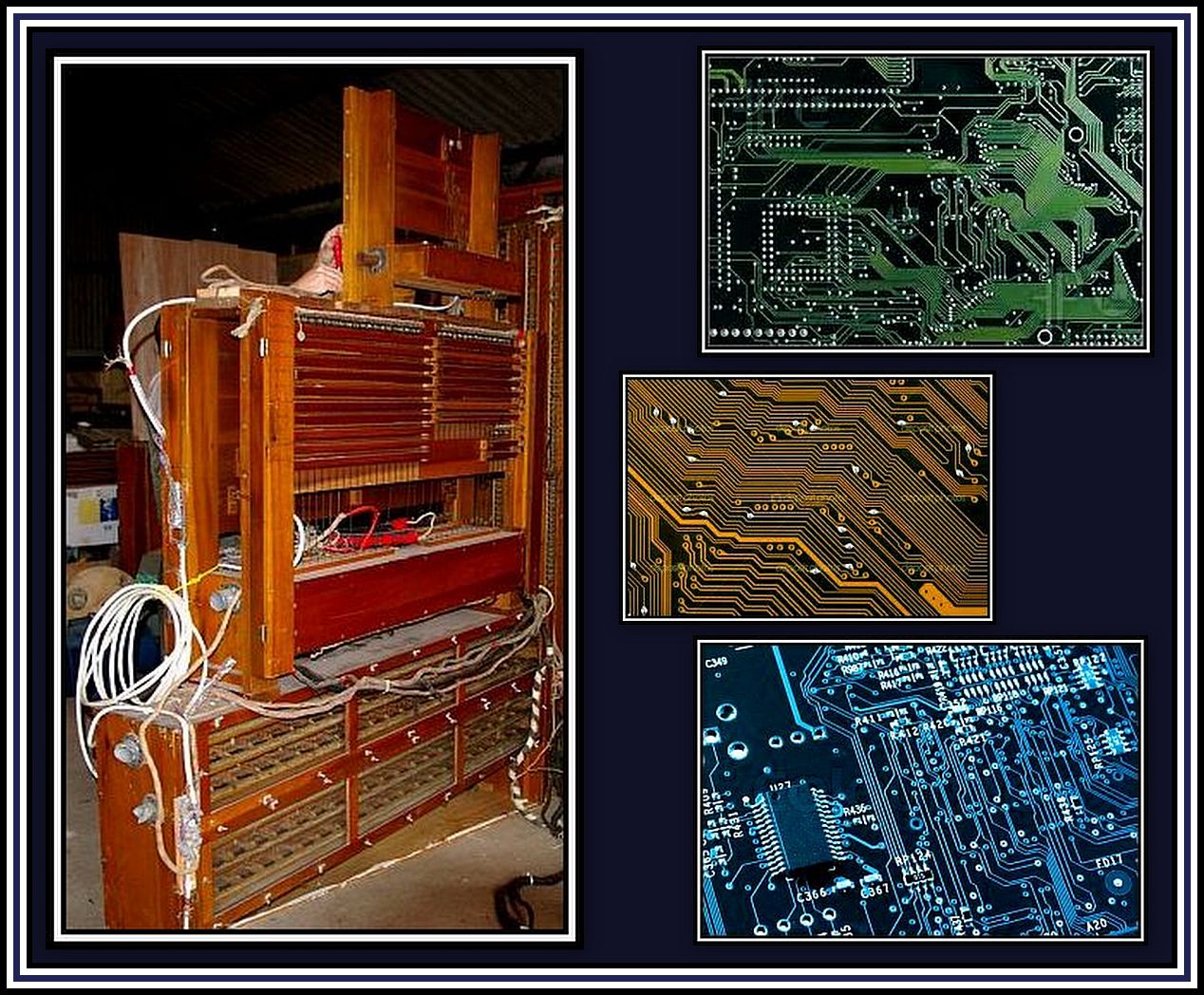 Relay System & Computer Circuit Boards
Relay System & Computer Circuit Boards
Left: Part of the Relay System of the Decca Studios Wurlitzer Organ
(this photograph appears here with the permission of the photographer, Mr. Wayne Ivany)
Right: Example of Computer Circuit Boards
(For readers wishing to learn more of the technical side of the electro-pneumatic system,
please see Page Five: The Electric-Pneumatic System of the Theatre Organ)
-oOo-
Another innovation that led to the success of the Theatre Organ was unification. Prior to this, each rank of pipes could only be played by one graduated set of similar pipes that produces a distinct sound; that is to say, one pipe for each key on the keyboard. With unification, the ranks were extended by adding more pipes and made playable at different pitch levels and on different manuals. As a result, fewer ranks, but with more pipes were now available in a variety of combinations and pitches and playable on different manuals at the same time. In addition, unification allowed any rank of pipes to be played from any manual or pedals independently, in contrast to the Pipe Organ where a particular rank of pipes is playable from one manual or pedals only unless couplers are used.
-oOo-
The Pipe Organ employed draw knobs found at the sides of the manuals to allow the stops to be played. This system proved inadequate to control the Theatre Organ, as the large number of draw knobs necessary would be unreachable by an organist while playing. This difficulty was overcome by the development of the Horseshoe Console by Robert Hope-Jones who employed tongue-shaped tabs arranged on a curved panel positioned around and above the manuals. All top flats are now within reach of the organist and so allow their opening and closing with ease and so allow any of the ranks to be brought into play.
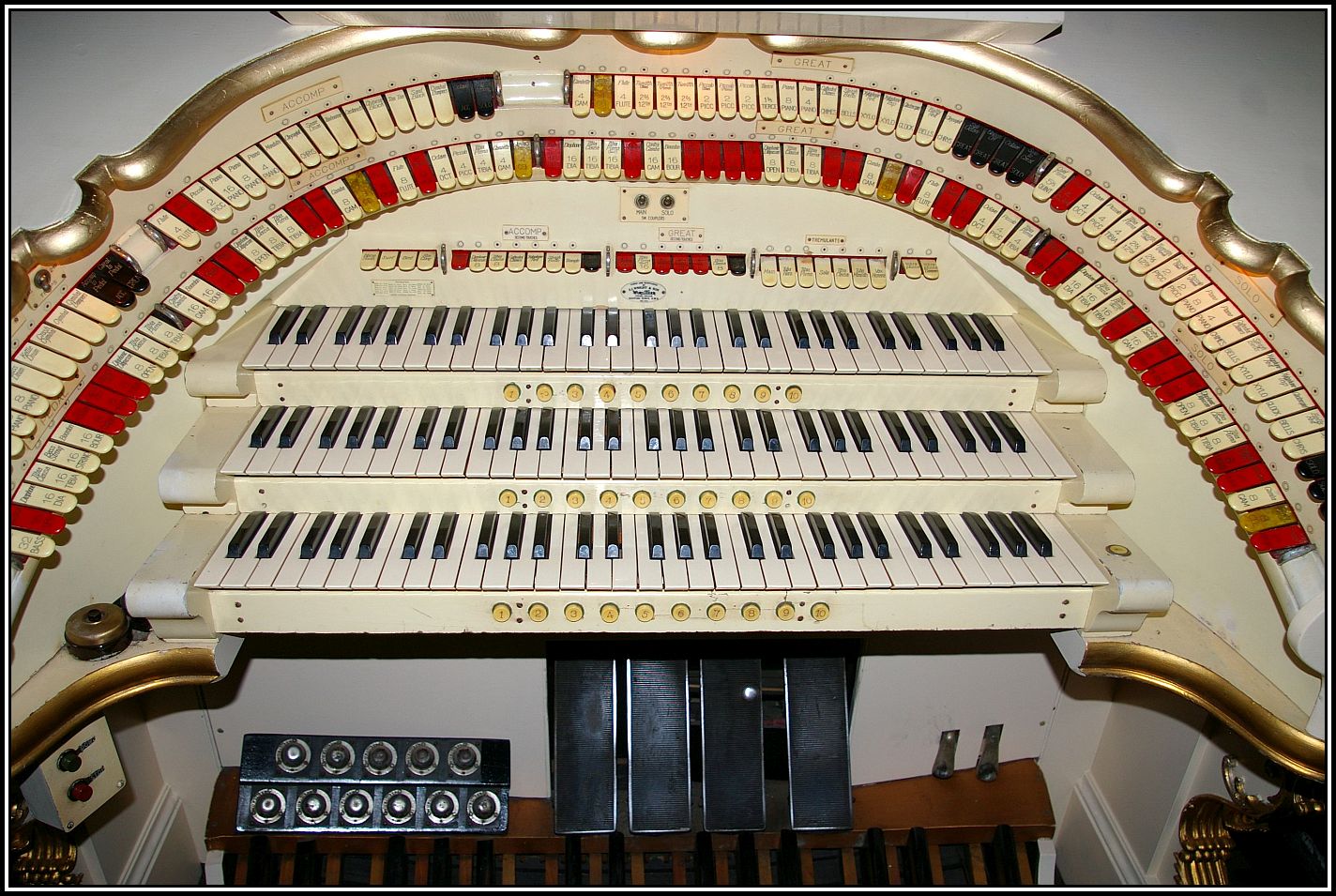 The Horseshoe Console of the Wurlitzer Organ installed at the Tower Ballroom, Blackpool
The Horseshoe Console of the Wurlitzer Organ installed at the Tower Ballroom, Blackpool
showing the Stop Tabs above and around the Manuals (Keyboards)
-oOo-
The sound volume produced by the pipes of the Theatre Organ was increased by higher wind pressures (see Glossary). According to the Cinema Organ Society, most Theatre Organs operate on pressures of 6-15 inches of water with some ranks on 25 inches of water on very large instruments. Classical Pipe Organs, which prior to the advert of electricity required wind to be supplied by the manual use of a bellows, and may use pressures between 2 and 6 inches of water with larger reeds in Cathedral Organs on higher pressures.
-oOo-
The pipes of the Theatre Organ were generally housed in the splays of the auditorium and were covered with a set of swell shades that could be opened and closed by use of a foot pedal. When closed, the sound of the pipes was greatly reduced, but could be increased by its opening. Although this concept was not new, Hope-Jones’ innovations allowed its range to be expanded.
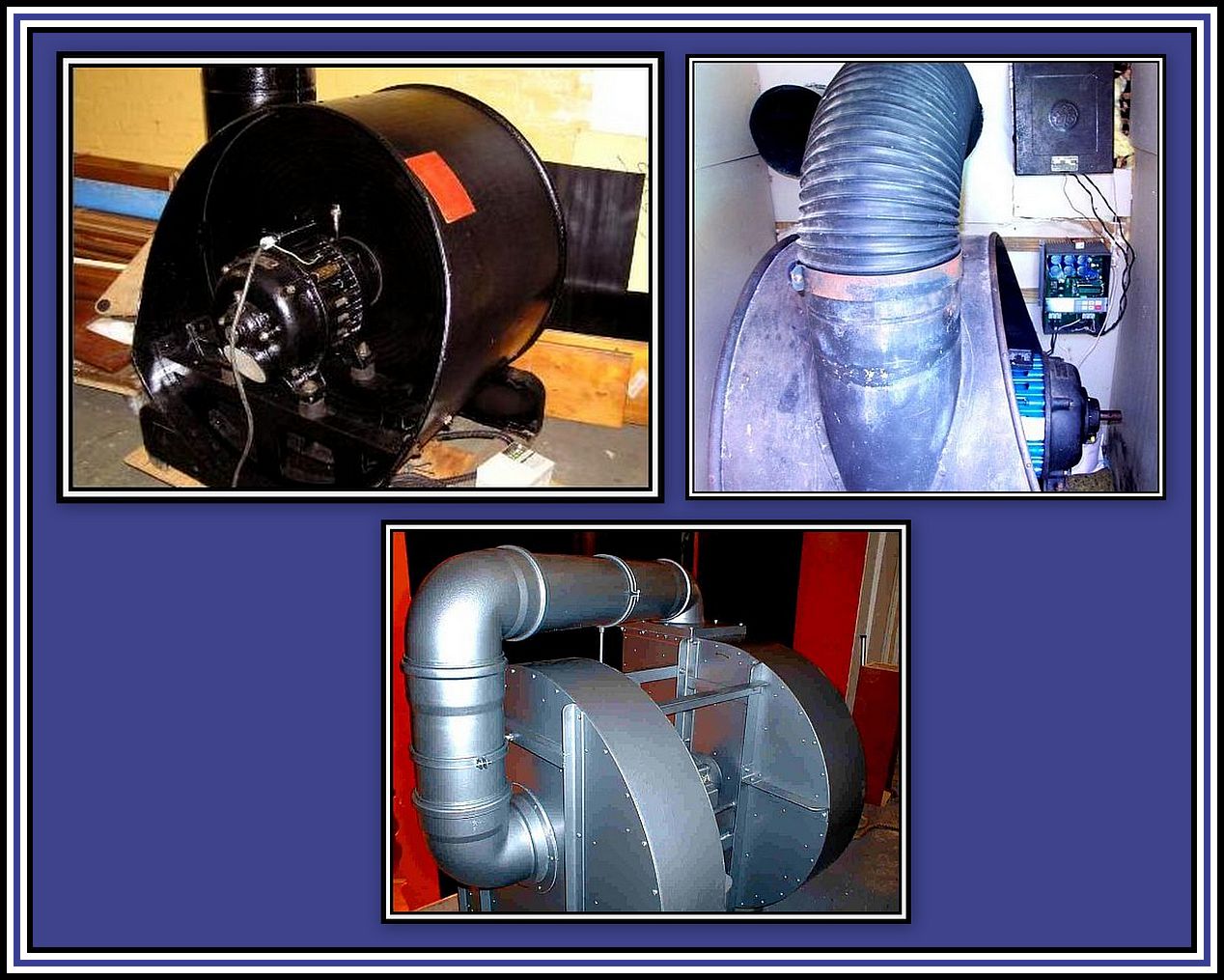 Turbines are used to produce Pressurised Air to open valves, operate percussions,
Turbines are used to produce Pressurised Air to open valves, operate percussions,
move stops and as a tone-producer when blown through pipes
Top Left: Spencer Orgoblo Blower (This photograph is from The Cinema Organ Society)
Top Right: Blower (This photograph is from Jerrell Kurtz’s Pipe Organ)
Bottom: Laukhoff Blowers
(This photograph is from The Organ of the Dome Concert Hall, Brighton)
-oOo-
Although it had been possible for years to produce a vibrato effect with a Pipe Organ by the use of a tremulant device, its use was only occasional. The effect was achieved by mechanically shaking the wind source and became refined and changed with the development of the Theatre Organ to great effect.
Many new kinds of pipes (stops) were designed by Robert Hope-Jones and others to imitate the sounds of various orchestral instruments, e.g. xylophone, wood-harps, chimes, sleigh bells, chysoglottis and glockenspiels (see Glossary) and so were able to extend the range of sounds available to the Unit Orchestra provided by the Theatre Organ. In addition, some stops were developed that were had no relationship to other orchestral instruments, which allowed new sounds to be associated with the Theatre Organ. Included in these new stops that were invented or refined by Mr. Jones were the Tibia Clausa, Tibia Plena and the Diaphone. Later Theatre Organs added other effects such as drums, cymbals and other percussive sounds.
—ooOoo—
With the development of talkies, the role of the Theatre Organ changed. No longer needed to provide atmosphere to the events on the screen, it was used to provide live entertainment and also to accompany the variety acts that often formed part of the séances or showings.
-oOo-
Later in Britain during the 1950s, a number of Theatre Organs were removed from cinemas and theatres and were often destroyed or sold to other venues including ice and roller shaking rinks, town halls, schools, restaurants, museums, churches etc. Only a few remain in their original venue. The Cinema Organ Society has three such organs and is also involved in the maintenance of others.
-oOo-
In North America, once talkies arrived the Theatre Organ lost for a time much of its prominence. They were removed quickly and many were sold: the Wurlitzer Organ at the Granada Theatre Tooting had been originally installed at The Majestic Theater, Sacramento, California. Theatre Organs gained a new lease of life when they were installed at radio stations, Baseball fields and Ice Hockey arenas. At sport facilities, they provided musical interludes and were also used to give effect to heighten the tension during the game, and in the case of baseball, to lead the crowd during the Seventh Inning Stretch with their singing of Take me out to the Ballgame.
 The Seventh Inning Stretch
The Seventh Inning Stretch
Other tunes heard during this time include: Lazy Mary, Centerfield, Meet me in St. Louis etc
-oOo-
Those cinemas that maintained their Theatre Organs in place, continued to offer musical interludes between films, which was generally greatly appreciated by the public. For many years, BBC Radio successfully presented weekly programmes featuring a popular organist at the organ of a specific venue. In addition, organists would give recitals, which were generally well-received by the public.
-oOo-
Regardless for the reasons of the Theatre Organ’s decline in popularity, concerts, recitals and musical interludes are still given and warmly received by those in attendance.
-oOo-
In addition, there remains a staunch group of followers who will continue to roar their appreciation immediately they hear the first note being struck on the keyboard and escaping the pipe to fill the auditorium. Their appreciation reaches a crescendo as the console majestically rises up from the depths of the orchestra pit and will continue as the glorious sound resonates throughout the auditorium. Their appreciation is eagerly on display until the sound of the final note disappears as the console slowly descends back to whence it came and is finally lost from view.
-oOo-
——-oooOOOooo——-
Click here to GO to PART TWO: BUILDERS OF THE THEATRE ORGANS
PART TWO consists of Five Pages
——oooOOOooo——
Click here to return to THE GLOSSARY
——oooOOOooo——
Click here to return to THE THEATRE ORGAN Home Page
——oooOOOooo——
——oooOOOooo——

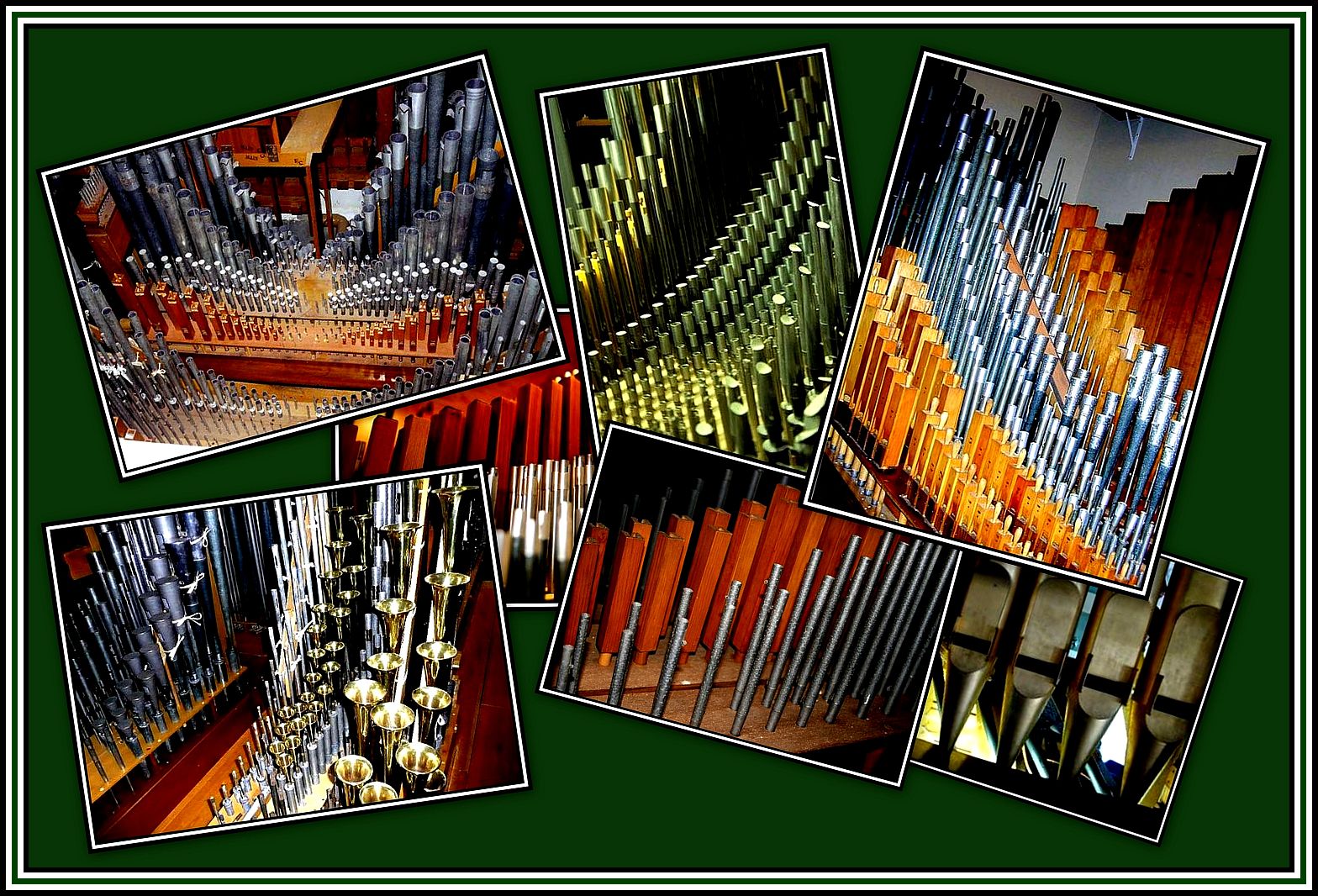
DEAR SIR, THE STORIES OF LONDON HAVE BEEN VERY INTERESTING , AND ALL ABOUT THE ORGAN . VERY WELL PUT TOGETHER. HOW EVER THERE IS ONE PARTICULAR ITEM IN THIS I AM INTERESTED IN AS THIS ITEM WAS FITTED TO OUR LOCAL CINEMA . THE ORGAN BUILT IN NINETEEN THIRTY FIVE WAS CALLED , THREE MANUAL/SEVERN RANKS CHRISTIE ORGAN WITH ILLUMINATED CONSOLE , THIS WAS INSTALLED IN THE MAJESTIC CINEMA/THEATRE IN REIGATE SURREY , HOWEVER, IN NINETEEN SEVENTY THREE IT WAS REMOVED AND SOLD. I AM TRYING TO LOCATE A PHOTO OF IT AND WHERE IT WAS SOLD TO ,AND, POSSIBLY THE SOUND OF THE ORGAN PLAYING, THIS IS ALL FOR THE MEMORIES OF REIGATE AND REDHILL WHICH IS BEING PUT TOGETHER. I AM SEVENTY FIVE NOW AND I REMEMBER LISTENING TO THE ORGAN IN MY YOUNGER DAYS AND IT SOUNDED ABSOLUTELY MARVELLOUS. YOUR HELP WOULD BE MUCH APPRECIATED. THANK YOU
Mr. Taylor: I have sent you an email reply. Thanks for reading some of my stories. Regards.